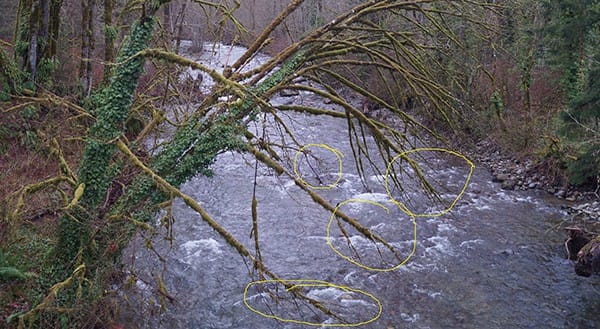Stay Safe on the River – Hazards and How to Avoid Them
Don’t let a lazy day on the river become a life-or-death situation. Learn to recognize dangers downstream.
by PJ Delhomme
No two rivers are the same, yet a few dangers are consistent with any river. For fishing guide and Bricklayers Local 1 OR/WA/ID/MT President Matt Eleazer, his home water is the Columbia River. The fourth biggest river in the U.S. by volume, it drains an area the size of France. With so much water washing down the hillsides of the Pacific Northwest, logs and other floating debris are his biggest concerns. “The river changes all the time,” he says. “When it rains, and the river rises, we get new obstacles. You always have to be aware of your surroundings.”
Strainers
Eleazer recommends keeping your head on a swivel, especially regarding a nasty and common feature known as a strainer. When trees or other obstacles get lodged in a river and allow water—but not solid objects—to pass through, the result is a strainer. They have killed many boaters and scared the crap out of even more. You’re not going over or through it. Typically, strainers consist of trees and their branches lying across the current, but they can also be old tires, bushes, vehicles, fences, roots—the list goes on. Take a wide birth or portage around this obstacle. If your boat gets pushed broadside against a strainer, lean slightly toward the obstacle rather than away. Try to pull yourself along it until you can get free. If you lean upstream, the current will catch the edge of the boat, flip it, and likely pin you underwater. Again, avoid strainers.

Only the tip of this boater’s packraft is visible above the waves after it got caught against the strainer pictured.
Sweepers
Like strainers, a sweeper typically involves a tree that desperately wants to ruin your river trip. As the name suggests, a sweeper can be a leaning or fallen tree (including its branches) that hangs over or into the water, waiting to sweep you off the boat. Typically caused by outer bank erosion, sweepers can appear suddenly in the river’s bend. The threat is made worse because the current tends to speed up on the outside edge, which will push your boat faster toward the obstacle and likely push you broadside against it—a very dangerous situation. It takes practice. If you’re uncomfortable with the technique, portage around it. Should you get pushed broadside into it, the self-rescue technique is similar to the strainer.

Like strainers, a sweeper typically involves a tree that desperately wants to ruin your river trip.
Dams, Weirs, and Spillways
Unless you’re a really dumb TikTok influencer, you won’t launch your boat over the Hoover Dam, but dams, weirs, and spillways can be found on any size of creek or river. They’re typically used for irrigation or flood control. These structures include any horizontal ledge that goes across the river. After the ledge, there is a drop. Because of their small size and drop, these structures often do not appear to be dangerous, but don’t think you’ll go over it and come out unscathed. On the downstream side of that ledge, the water circulates on top of itself in a churning froth of anger. River people and scientists call them hydraulics, and you should avoid it.

Low-head dams have a recirculating current that make them highly dangerous.
Hypothermia
You can’t see the temperature of a river, but you should pay attention to it. Even water that’s 75 to 80 degrees Fahrenheit can cause hypothermia, which causes loss of muscle coordination and fatigue. Hypothermia sets in faster as the water temperature drops. Hit 40 degrees, and you might have 20 minutes to live. Always wear a PFD, and if you do fall in, warm up with dry clothes and warm fluids.
Scout It Out
This article isn’t meant to scare you off of the water. We just want you to be safe out there. Rivers are dynamic and change every year. Before you get on the water, talk to local fly-fishing or rafting shops about the conditions. Check the internet for river-specific forums and other sites. Chances are you will find recent updates on water levels, fishing, and hazards. Once you have your intel, slather on sunscreen and prepare for a great adventure on the river.
PJ DelHomme writes and edits content from his home in western Montana. He runs Crazy Canyon Media and Crazy Canyon Journal.
More articles in our Be An Expert on the Water series!








